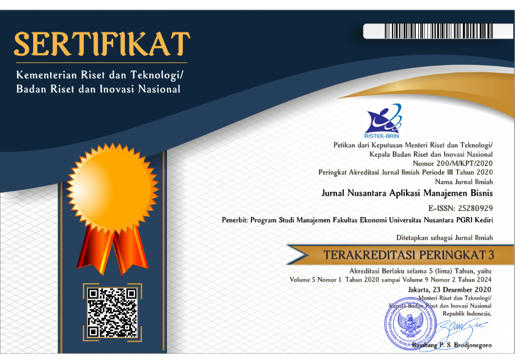Transformasi Wisata Kapalo Banda: Studi Strategis Dengan Matriks EFI, EFE, IE, SWOT, Dan QSPM
DOI:
https://doi.org/10.29407/nusamba.v10i1.22869Keywords:
Strategi, SWOT, QSPM, Wisata, Kapalo BandaAbstract
Research aim: This research aims to design an appropriate strategy that can be applied to efforts to develop the Kapalo Banda tourist attraction.
Methode: Qualitative Descriptive, namely this research describes the condition of objects, both external and internal, naturally and objectively using the strategy selection stage in the form of the input stage with the EFI Matrix and EFE Matrix, the matching stage with the IE Matrix and SWOT Matrix, and the decision stage with the QSPM Matrix
Research Finding: The results of data analysis at the matching stage using the IE Matrix obtained a strategy in Quadrant II. Then, at the strategy matching stage with the SWOT Matrix, eight types of strategies were obtained that could be used in the development of Kapalo Banda tourism.
Theoretical contribution: This study can explain the importance of tourism area development strategies for attracting visitors by continuously identifying internal strengths and external threats.
Practical implication: The resulting alternative strategies can be implemented in stages, based on the needs and capabilities of existing resources.
Research limitation: This research focuses on the Kapalo Banda tourist attraction in Kenagarian Taram, Limapuluh Kota Regency
Downloads
References
[1] Lumansik JRC, Kawung GM V, Sumual JI. Analisis Potensi Sektor Pariwisata Air Terjun Di Desa Kali Kecamatan Pineleng Kabupaten Minahasa [Internet]. Minahasa; 2022 Jan [dikutip 9 Oktober 2024]. Tersedia pada: https://ejournal.unsrat.ac.id/v3/index.php/jbie/article/view/38177/34885
[2] Cooper C, FJ, GD, WS. Tourism: Principles and Practice. 1 ed. Vol. 6. Harlow, United Kingdom: Pearson Education; 2019. 1–198 hlm.
[3] Intan Wahyuningtyas, Ulfatul Hasanah, Luki Widiyanto. Parade Pegon Sebagai Budaya Lokal Pada Masyarakat Kecamatan Ambulu Kabupaten Jember Tahun 2024. Journal of Comprehensive Science (JCS) [Internet]. Mei 2024 [dikutip 9 Oktober 2024]; 3:965–70. Tersedia pada: https://jcs.greenpublisher.id/index.php/jcs/article/view/732
[4] Prakoso AA. Konsep Dan Teori Desa Wisata. 1 ed. Vol. 1. Banyumas: CV. Pena Persada; 2022. 1–115 hlm.
[5] Middleton V, Clarke J. Marketing in Travel and Tourism. Oxford, Inggris: Butterworth-Heinemann; 2021. 1–528 hlm.
[6] Kotler P, Bowen TT, Makens JC. Marketing for Hospitality and Tourism. 1 ed. Vol. 1. Boston, Massachusetts, Amerika Serikat: Pearson; 2017.
[7] Rangkuti F. Analisis SWOT: Konsep dan Aplikasi. 3 ed. Jakarta: Gramedia Pustaka Utama; 2019. 1–350 hlm.
[8] Kotler P, Bowen JT, Makens JC. Marketing for Hospitality and Tourism. 7 ed. Boston: Pearson; 2020. 1–608 hlm.
[9] David FR. Strategic Management: A Competitive Advantage Approach, Concepts. 17 ed. Upper Saddle River, NJ; 2020. 1–560 hlm.
[10] Luqma ML, Susilowati D, Sari NP. Peran Ekonomi Kreatif Dan Sektor Pariwisata Dalam Pertumbuhan Ekonomi di Indonesia. Community Dev J [Internet]. Juni 2023 [dikutip 9 Oktober 2024];4(Juni):3331–9. Tersedia pada: https://journal.universitaspahlawan.ac.id/index.php/cdj/article/view/15245/11758
[11] Lamopia IWG, Nindya PAA. Pengembangan model baru strategi pemulihan pariwisata bali berbasis wisata berkelanjutan. Vol. 12. 2023 Jan.
[12] Kementrian Pariwisata dan Ekonomi Kreatif, Badan Pariwisata dan Ekkonomi Kreatif Republik Indonesia. Panduan Potensi Pembangunan Sektor Pariwisata dan Ekonomi Kreatif. https://kemenparekraf.go.id/ragam-pariwisata/Panduan-Potensi-Pembangunan-Sektor-Pariwisata-dan-Ekonomi-Kreatif. 20 September 2024;
[13] Dewi K. Pengaruh produk wisata dan kebijakan harga terhadap minat kunjungan wisatawan. 2019;17(2). Tersedia pada: https://amptajurnal.ac.id/index.php/MWS
[14] Nugraha YE. Sosialisasi Sadar Wisata Sebagai Upaya Pengembangan Desa Wisata Berbasis Masyarakat di Desa Fatukoto [Internet]. Vol. 2. 2021 [dikutip 9 Oktober 2024]. Tersedia pada: https://jurnal.ampta.ac.id/index.php/JAP/article/view/24
[15] Semara SMD, Suryasih IA, Nugroho S. Peran Stakeholder Dalam Pengembangan Desa Wisata Paksebali di Kecamatan Dawan, Kabupaten Klungkung, Bali. Jurnal Ilmiah Wahana Pendidikan [Internet]. 17 Januari 2024 [dikutip 9 Oktober 2024];10(Maret 2024):783–90. Tersedia pada: file:///C:/Users/alfik/Downloads/8594-Article%20Text-20127-1-10-20240121.pdf
[16] Rosita I, Fauz N. Pelatihan Penyusunan Laporan Keuangan Berbasis Digital pada Kelompok Pengelola Wisata Kapalo Banda Taram. Jurnal Abdimas: Pengabdian dan Pengembangan Masyarakat [Internet]. Desember 2021 [dikutip 9 Oktober 2024];3(Desember 2021):41–5. Tersedia pada: file:///C:/Users/alfik/Downloads/708-Article%20Text-2503-2-10-20211230.pdf
[17] Rahayu M, Pratama YS. Pengelolaan Pengunjung di Kawasan Wisata Alam Lolai Kabupaten Toraja Utara [Internet]. Vol. 6, Jurnal Pariwisata Terapan. 2022 [dikutip 10 Oktober 2024]. Tersedia pada: https://jurnal.ugm.ac.id/jpt/article/view/73054
[18] Agustin H, Arianto ME, Rifai M. Pendampingan Pengembangan Sistem Manajemen Kesehatan dan Keselamatan Kerja (SMK3) di Destinasi Wisata Tanah Tebing Breksi, D.I. Yogyakarta. MARTABE: Jurnal Pengabdian Masyarakat. 2021; 4:679–86.
[19] Ayu MP, Setya Kemalasari A, Sofia M. Pengembangan Pariwisata Budaya di Kawasan Dataran Tinggi Dieng dalam Satu Dasawarsa Dieng Culture Festival [Internet]. Vol. 2. Jakarta; 2020 Feb [dikutip 10 Oktober 2024]. Tersedia pada: https://journal.uib.ac.id/index.php/altasia/article/view/564
[20] Sutrisno ER, Ngangi CR, Pakasi CBD. Analisis Strategi Pengembangan Pariwisata Kawasan Selat Lembeh Di Kota Bitung. Agri-SosioEkonomi Unsrat [Internet]. 2018 [dikutip 10 Oktober 2024]; 14:95–110. Tersedia pada: https://ejournal.unsrat.ac.id/v3/index.php/jisep/article/view/20374
[21] Prathama A, Nuraini RE, Firdausi Y. Pembangunan pariwisata berkelanjutan dalam prespektif lingkungan (studi kasus wisata alam waduk gondang di kabupaten lamongan) [Internet]. 2020 [dikutip 10 Oktober 2024]. Tersedia pada: file:///C:/Users/alfik/Downloads/Pembangunan%20Pariwisata%20Berkelanjutan%20Dalam%20Prespektif%20Lingkungan%20(Studi%20Kasus%20Wisata%20Alam%20Waduk%20Gondang%20Di%20Kabupaten%20Lamongan).pdf
[22] Putra GA, Sunoko K, Cahyono UJ. Pendekatan Ecotourism Pada Desain Waterfront Resort Hotel di Kawasan Wisata Alam Kapalo Banda Taram [Internet]. Juli. 2022 [dikutip 10 Oktober 2024]. Tersedia pada: https://jurnal.ft.uns.ac.id/index.php/senthong/article/view/1486
[23] Ardia U, Wulandari DP. Dampak Sosial Ekonomi Masyarakat di Wisata Alam Kapalo Banda Nagari Taram Kabupaten Lima Puluh Kota. Jurnal Pendidikan Tambusai [Internet]. Agustus 2022 [dikutip 10 Oktober 2024];6(Agustus 2022):12631–7. Tersedia pada: https://jptam.org/index.php/jptam/article/view/3832/3721
[24] Refa A, Maharani S, Lisna YP, Susanti R. Pengaruh atraksi wisata dan fasilitas terhadap revisit intention di daya tarik wisata alam kapalo banda nagari taram kabupaten lima puluh kota.
[25] Eddyono F. Pengelolaan destinasi pariwisata. 1 ed. Vol. 1. Ponorogo: Uwais Inspirasi Indonesia; 2021.
[26] Wheelen TL, Hunger JD. Strategic Management and Business Policy: Toward Global Sustainability. 13 ed. Vol. 1. Pearson Education; 2012. 1–880 hlm.
[27] Suarto E. Pengembangan objek wisata berbasis analisis swot [Internet]. [dikutip 10 Oktober 2024]. Tersedia pada: https://ejournal.upgrisba.ac.id/index.php/spasial/article/view/1597/904
[28] Adityaji R. Formulasi strategi pengembangan destinasi pariwisata dengan menggunakan metode analisis swot: studi kasus kawasan pecinan kapasan surabaya. Jurnal Pariwisata Pesona [Internet]. 30 Juni 2018 [dikutip 10 Oktober 2024];3(1):19–32. Tersedia pada: https://jurnal.unmer.ac.id/index.php/jpp/article/view/2188/1459
[29] Yulivestra M, Ichsan Kabullah Hendri Koeswara Novalinda M. Management and Development of Community-Based Ecotourism Destinations in West Sumatra. International Journal Of Agricultural Sciences [Internet]. 2023;7(1):16–23. Tersedia pada: http://ijasc.pasca.unand.ac.id
Downloads
Published
Issue
Section
License
Copyright (c) 2025 Alfikri, Silfia, Darnetti, Nelvia Iryani

This work is licensed under a Creative Commons Attribution-ShareAlike 4.0 International License.
Authors who publish with this journal agree to the following terms:
- Copyright on any article is retained by the author(s).
- The author grants the journal, the right of first publication with the work simultaneously licensed under a Creative Commons Attribution License that allows others to share the work with an acknowledgment of the work’s authorship and initial publication in this journal.
- Authors are able to enter into separate, additional contractual arrangements for the non-exclusive distribution of the journal’s published version of the work (e.g., post it to an institutional repository or publish it in a book), with an acknowledgment of its initial publication in this journal.
- Authors are permitted and encouraged to post their work online (e.g., in institutional repositories or on their website) prior to and during the submission process, as it can lead to productive exchanges, as well as earlier and greater citation of published work.
- The article and any associated published material is distributed under the Creative Commons Attribution-ShareAlike 4.0 International License












